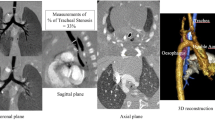Abstract
Background
Postintubation stenosis remains the most frequent indication for tracheal surgery. Rigid bronchoscopy has traditionally been considered the technique of choice for the preoperative diagnostic assessment. However, this technique is not routinely available, and new techniques such as flexible videobronchoscopy and spiral computed tomography (CT) scan with multiplanar reconstructions have been proposed as alternatives to rigid bronchoscopy. The aim of this study was to compare these techniques in the diagnostic assessment of patients with tracheal stenosis submitted to surgical treatment.
Methods
Twelve patients who underwent airway resection and reconstruction for postintubation tracheal and laryngotracheal stenosis were preoperatively evaluated with rigid and flexible bronchoscopy and with spiral CT scan with multiplanar reconstructions. The following parameters were examined: involvement of subglottic larynx, length of the stenosis, and associated lesions. The results were compared with the intraoperative findings.
Results
The accuracy of rigid bronchoscopy, flexible bronchoscopy, and CT scan in the evaluation of the involvement of subglottic larynx was, respectively, 92%, 83%, and 83%. The evaluation of the length of the stenosis was correct in 83%, 92%, and 25% of the patients, respectively, with rigid bronchoscopy, flexible bronchoscopy, and CT scan. A significant correlation was observed between the length of the stenosis measured intraoperatively and preoperatively with rigid (p < 0.001) and flexible bronchoscopy (p < 0.05) but not with CT scan (p = 0.08). The three techniques correctly showed the presence of an associated tracheoesophageal fistula in two patients, but CT scan did not correctly show the exact location of the fistula in relation to the airway. Flexible bronchoscopy was the only effective technique in the assessment of laryngeal function.
Conclusions
Rigid bronchoscopy remains the procedure of choice in the evaluation of candidates for tracheal resection and reconstruction for postintubation stenosis, and it should be available in centers that perform surgery of the airway. Flexible bronchoscopy and CT scan have to be considered complementary techniques in the evaluation of laryngeal function and during follow-up.

Similar content being viewed by others
References
Grillo HC, Cooper JD, Geffin B, Pontoppidan H (1971) A low-pressure cuff for tracheostomy tubes to minimize tracheal injury. J Thorac Cardiovasc Surg 62: 898–907
Grillo HC, Donahue DM, Mathisen DJ (1995) Postintubation tracheal stenosis. J Thorac Cardiovasc Surg 109: 486–493
Grillo HC, Mathisen DJ, Wain JC (1992) Laryngotracheal resection and reconstruction for subglottic stenosis. Ann Thorac Surg 53: 54–63
Pearson FG, Cooper JD, Nelems JM, Van Nostrad AWP (1975) Primary tracheal anastomosis after resection of the cricoid cartilage with preservation of recurrent laryngeal nerves. J Thorac Cardiovasc Surg 70: 806–816
Couraud L, Jougon JB, Velly JF (1995) Surgical treatment of non-tumoral stenoses of the airway. Ann Thorac Surg 60: 250–260
Weber AL, Grillo HC (1992) Tracheal lesions-assessment by conventional films, computed tomography and magnetic resonance imaging. Isr Med Sci 28: 233–240
LoCicero JL III, Costello P, Campos Christian T, Francalancia N, Dushay KM, Silvestri RC, Zibrak JD (1996) Spiral CT with multiplanar and 3D reconstructions accurately predicts tracheobronchial pathology. Ann Thorac Surg 62: 811–817
Jewett BS, Cook RD, Johnson KL, Logan TC, Rosbe KW, Mukherji SK, Shockley WW (1999) Subglottic stenosis: correlation between computed tomography and bronchoscopy. Ann Otol Rhinol Laryngol 108: 837–841
Grillo HC, Zannini P, Michelassi F (1986) Complication of tracheal reconstruction. J Thorac Cardiovasc Surg 91:322
Filkenstein SE, Schrump DS, Nguyen DM, Hewitt SM, Kunst TF, Summers RM. Comparative evaluation of super high-resolution CT scan and virtual bronchoscopy for the detection of trachobronchial malignancies. Chest 2003; 124:134–1840
Author information
Authors and Affiliations
Corresponding author
Rights and permissions
About this article
Cite this article
Carretta, A., Melloni, G., Ciriaco, P. et al. Preoperative assessment in patients with postintubation tracheal stenosis. Surg Endosc 20, 905–908 (2006). https://doi.org/10.1007/s00464-005-0475-0
Received:
Accepted:
Published:
Issue Date:
DOI: https://doi.org/10.1007/s00464-005-0475-0




